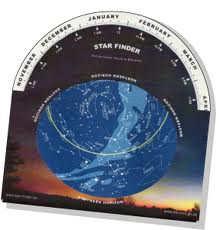Preliminary Report on Astronomical Clock (2008)
The basic idea is to automate a 'star finder'
such as the one shown here.  (from star-finder.ca)
(from star-finder.ca)
The stars are shown on a wheel that can rotate in such a way that the position in your night sky is shown in the oval window which represents your horizon - the bowl of sky overhead.
That is all good fun but what about the moon and the planets?
Well they move too fast to be printed on a finder. So I thought to use a robot hand to pick up tiny magnets to represent the moon and the five visible planets known from the dawn of man and place them correctly with the stars.
For a given date the robot hand (called the 'hand of god') places all these objects in their correct location on the star chart. Then the star wheel rotates to the correct position relative to your horizon. The star wheel's rotation is updated minute by minute as the earth turns. This way the time of day is also shown. The star wheel is 12 inches in diameter.
Here is the star wheel and 'hand of god' in action on the first day of operation Aug 30, 2008. (should work in: IE9+, Chrome 6+, Safari 5+, Firefox 3.6+, and Opera 10.6+)
Here is a close up of the jaws picking up and placing a planet magnet.
Here is a bit more of the picking and placing. The magnets are stored in a parking lot row when they are not actually in position on the map. Here too is shown the huge gear that drives the star wheel. This was made on a laser cutter in plastic by Ponoko a company that takes your drawings and returns physical objects. (Way cool.)
One of the magnets is placed over the correct date.
An etched plastic ring surrounds the star wheel to
show the current time.
December 20 at 8:45PM. 
Here the oval window of the star finder
is replaced by an etched plastic
plate that covers the star wheel and shows the altitude
and azimuth of objects on the chart.
The photograph below shows the plate in high
contrast so the etched lines can be seen.
(Admittedly not my best photographic work.)
The outer line is the local horizon.
The plate is designed for a specific latitude.
At the top is North and below it at the bottom
is South.
Because of the map projection used for the
star chart the azimuth lines for East and
West curve strongly up with West at the right.

A small oval in the center marks 80° above local horizon. A middle oval marks 40°. The horizon plate is positioned so that the North Star is about 53° above the North horizon for my location 40 miles South of San Francisco. The position of the Sun is also shown by a magnet. As this magnet crosses the outer oval - well that is sunrise in the East and sunset in the West. And as the Sun marker passes the vertical line between North and South that is solar noon. By this method the rising and setting of all bodies can be computed approximately.
A mechanism (not yet built) moves this plate out of the way to allow the hand of god to do its work.
This detail photo shows a planet marker on the
gray ecliptic line just above 40° above the
horizon and in the West.
The etched lines can be seen somewhat.
A late afternoon Sun used to make this photo in
the driveway casts shadows far to the left of
the etched lines.

I have written all the software for this project including all the astronomical and map projection stuff. An interesting problem there was what I call 'the parking problem.' The markers are many degrees in diameter on the map while the objects themselves are much smaller. Often to bodies will collide on the map and must be repositioned. Currently the code creates all dates from 1900 to 2050.
There is a lot left to do on this project. A case has to be built. Power supplies have to be rounded up. Sensors have to be added to locate the 'zero' position of the star wheel and the robot arm. The etched horizon plate has to be edge lit to highlight the etched lines. (A florescent tube is in hand but maybe white LEDs are better.) A servo has to be added to lift the horizon plate out of the hand of god's way.
Currently I have a plan to use a small Linux single board computer (Beaglebone etc.) to run everything. Such a machine can be on the local network and be controlled from a website on a tablet. That will allow the Moon phases to be shown too.
So far so good. But lots more to do.(rlb)

